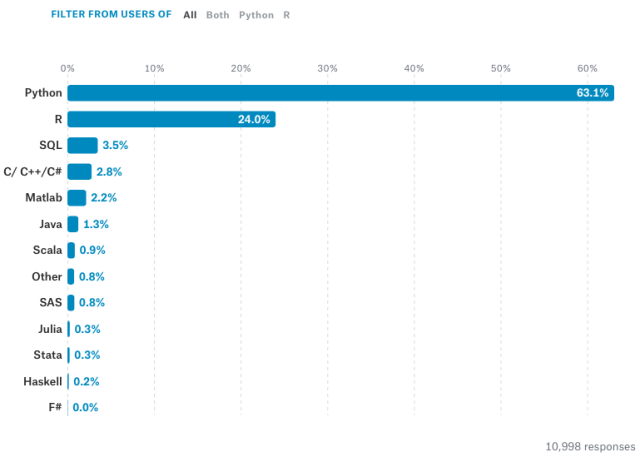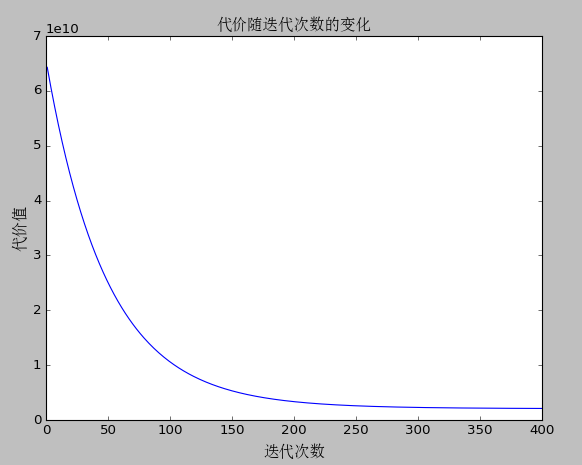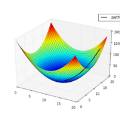用Python实现机器学习算法:线性回归
在 Kaggle 最新发布的全球数据科学/机器学习现状报告中,来自 50 多个国家的 16000 多位从业者纷纷向新手们推荐 Python 语言,用以学习机器学习。

线性回归
https://github.com/lawlite19/MachineLearning_Python/tree/master/LinearRegression
全部代码
https://github.com/lawlite19/MachineLearning_Python/blob/master/LinearRegression/LinearRegression.py
代价函数
其中:
下面就是要求出theta,使代价最小,即代表我们拟合出来的方程距离真实值最近
共有m条数据,其中
前面有系数2的原因是下面求梯度是对每个变量求偏导,2可以消去
实现代码:
# 计算代价函数
def computerCost(X,y,theta):
m = len(y)
J = 0
J = (np.transpose(X*theta-y))*(X*theta-y)/(2*m) #计算代价J
return J
注意这里的X是真实数据前加了一列1,因为有theta(0)
梯度下降算法
代价函数对
所以对theta的更新可以写为:

为什么梯度下降可以逐步减小代价函数?
假设函数f(x),泰勒展开:f(x+△x)=f(x)+f'(x)*△x+o(△x),
令:△x=-α*f'(x) ,即负梯度方向乘以一个很小的步长α
将△x代入泰勒展开式中:f(x+x)=f(x)-α*[f'(x)]²+o(△x)
可以看出,α是取得很小的正数,[f'(x)]²也是正数,所以可以得出:f(x+△x)<=f(x)
所以沿着负梯度放下,函数在减小,多维情况一样。
# 梯度下降算法
def gradientDescent(X,y,theta,alpha,num_iters):
m = len(y)
n = len(theta)
temp = np.matrix(np.zeros((n,num_iters))) # 暂存每次迭代计算的theta,转化为矩阵形式
J_history = np.zeros((num_iters,1)) #记录每次迭代计算的代价值
for i in range(num_iters): # 遍历迭代次数
h = np.dot(X,theta) # 计算内积,matrix可以直接乘
temp[:,i] = theta - ((alpha/m)*(np.dot(np.transpose(X),h-y))) #梯度的计算
theta = temp[:,i]
J_history[i] = computerCost(X,y,theta) #调用计算代价函数
print '.',
return theta,J_history
均值归一化
目的是使数据都缩放到一个范围内,便于使用梯度下降算法


实现代码:
# 归一化feature
def featureNormaliza(X):
X_norm = np.array(X) #将X转化为numpy数组对象,才可以进行矩阵的运算
#定义所需变量
mu = np.zeros((1,X.shape[1]))
sigma = np.zeros((1,X.shape[1]))
mu = np.mean(X_norm,0) # 求每一列的平均值(0指定为列,1代表行)
sigma = np.std(X_norm,0) # 求每一列的标准差
for i in range(X.shape[1]): # 遍历列
X_norm[:,i] = (X_norm[:,i]-mu[i])/sigma[i] # 归一化
return X_norm,mu,sigma
注意预测的时候也需要均值归一化数据
最终运行结果
代价随迭代次数的变化
使用scikit-learn库中的线性模型实现
https://github.com/lawlite19/MachineLearning_Python/blob/master/LinearRegression/LinearRegression_scikit-learn.py
导入包
from sklearn import linear_model
from sklearn.preprocessing import StandardScaler #引入缩放的包
归一化
# 归一化操作
scaler = StandardScaler()
scaler.fit(X)
x_train = scaler.transform(X)
x_test = scaler.transform(np.array([1650,3]))
线性模型拟合
# 线性模型拟合
model = linear_model.LinearRegression()
model.fit(x_train, y)
预测
#预测结果
result = model.predict(x_test)
(未完待续)
作者:lawlite19
来源:
https://github.com/lawlite19/MachineLearning_Python#











